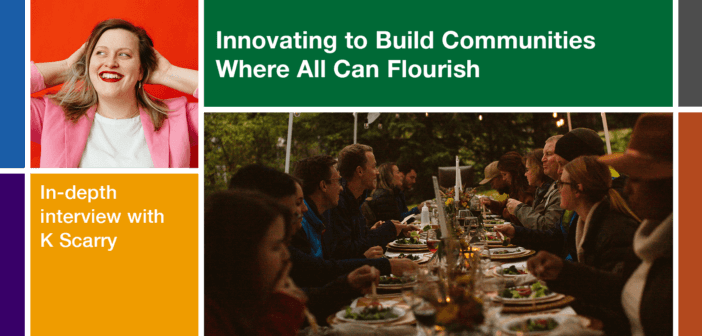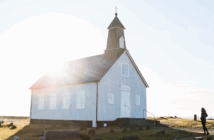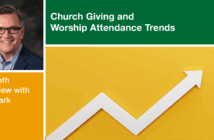How can a passion for helping people flourish lead to social innovation? K Scarry share about social innovation and the ways she is supporting local artists, helping create spaces where everyone can thrive, and more.
Watch the interview video on YouTube, listen to this interview, or continue reading.
Doug Powe: Share a little bit about yourself and how you got into the space of social innovation.
K Scarry: I have always been curious about communities, how they form, and how we build relationships of mutuality. When I think about how this started for me, a couple of stories come to mind.
When I was younger, I had a couple of dear family members, one of whom was experiencing homelessness and one of whom was incarcerated. I remember being in spaces where I heard how other adults, families, peoples, or culture were talking about the unhoused population and/or incarcerated individuals. I remember even from a young age thinking there’s more to the story here. It really drove a curiosity in me and an inability to dehumanize people in scenarios that I haven’t had to experience before. I think that started a spark of curiosity in me alongside some real empathy and longing for what happens when the people in our communities don’t have the support that they to be well.
I was in middle school when hurricane Katrina hit. I remember being really devastated about watching that on the news. My dad talked with me when he realized I couldn’t let it go. He helped me think about some things I could do. He recommended that I make a phone call to a grocery store, organize a bake sale, and send the money. Even from a young age, I was empowered to look at what I had in front of me, consider where I was, what I had, what I could do, and do something, trusting that it contributes to something bigger than what I could do on my own. That really sparked something in me that has been a thread my whole life of exploring what it is to build communities where everyone can flourish, where everyone has the support and tools they need and how do we creatively invite people into imagining what might be possible for them?
Doug Powe: I would say 100% you have. What I find is fascinating is the way that you marry your love of theology with this love of creativity. Lately, you’ve come up with this interesting and creative idea of vending machine art as a way of sharing the work of the community. Share about that and how this could be helpful for a congregation thinking about doing something creative like this.
K Scarry: It’s not totally my original idea. My husband and I were on a trip to Miami a year and a half ago and had a long layover in Chicago where we stumbled upon what’s called a creative vending machine. It had nontraditional items in it, like nostalgia items, vintage items, and some local art. We were really taken by this, and I’d already built a practice of keeping a note on my phone of anything that inspires me and noticing where there are threads, resonance, and through lines. There is a D. C. company that vends locally made snacks, which is also a cool iteration of vending with the local community in mind. We really wanted to do it as a way of supporting local artists. I like to buy local art, so it helps satisfy that desire. A year ago, we started exploring what it would look like to buy art from all kinds of local folks making art and other handmade things. We have somebody who has a lathe and makes wood turned items like the bottle openers we have in the machine. It’s not just fine art. The first vending machine we had is set up in a brewery in Sterling, Virginia, where we vend all locally made goods, for the most part. There’s a couple of items that are convenience items and that’s how we make business work by having 75% of it be locally made and about 25% of it be not locally made but higher profit margin so that we can pay artists well while also making the business work without requiring the growth of the business to be on the shoulders of artists.
I love so many things about it. On the one hand, we are working with 43 different local artists in this one machine and are in the process of expanding. I love that it’s meant we’ve gotten to know different venue and led to other types of collaboration. We have products from a soap maker who makes soap out of beers. Since the machine is in a brewery, he and the brewery have collaborated. So that’s kind of fun and generative in that way. I love thinking about how we get people into a backdoor conversation into the most important conversations of our time.
People have lots of questions about our vending machine and I get to tell them about the artist who’s a single mom, and the three men in our town who are nonverbal and who have autism, who make a suite of excellent skincare body products that we have in the vending machine, but obviously they can’t ever sell at a market. Now suddenly we’re having a conversation about access and equity with people who might never show up to that seminar, which is interesting to the point of what can churches do?
When the dominant conversation I hear about churches is long term survival, capacity, energy, and resources, it’s not that expensive to start up a vending machine company and it doesn’t require staffing. You can stock it on your own time, you can set it up and it becomes an interesting storytelling and connecting device. I’m not saying all churches should start a vending machine. What I am saying is what’s the kind of energetic, creative space or what are things that connect us to our local community and the places that they come alive? What are the things that don’t require a ton of time, energy, capacity, resources, that also don’t compromise our loving of our neighbors and our local community? If we want to get theological, there’s also something kind of fun about the reclaiming of an item that was used for one thing and transforming it into using it for something else.
Doug Powe: What I think is particularly important is the relational piece. I know that you started a version of a house church by hosting people weekly in your home. So, share about how that got started and how you built relationships with these different individuals. One of the challenges for congregations is that relational building piece, particularly with those who are outside of the congregation. It’s something that for you sort of comes naturally, but how did you go throughout the community and say, “hey, come to my house so we can get together and sort of do what I’m calling house church?”
K Scarry: We still do this, and I will also push on it coming naturally. I feel like you’ve gotten to know me at a point where I’ve built up some serious musculature around this, but it didn’t start that way. I’ve built my own hacks for getting myself to do the thing that I want to do that I often get in my own way around. In 2015 we started what we affectionately called Tuesday Night Dinner and “we” was mostly me, but now my husband and I do this together. We weren’t together then, but now we do this together. I think it started out of a real conviction that people needed a consistent place they could belong.
Even when I was a kid, when people asked me what I wanted to be when I grew up, I thought a lot about how cool would it be if I was so faithful to have dinner at my house at the same time, every week that someone could be passing through that I hadn’t seen for 20 years and be say, “Oh, K lives here and it’s Tuesday night. There’s dinner at her house and I can go.” I love that as a vision for community, hospitality, connection, and trust between people. In 2015, after a hard couple of years I was struggling to find my own creative spark and energy, and this felt like a thing I could do. I decided I was going to do this thing I’d talked about doing forever. I’d moved back to the town I grew up in. So, I would invite anybody I found out was in my town that I had grown up with. What was great about that is it didn’t give me the ability in a moment to find out someone was back in town and then do the mental gymnastics of, should I invite them? Is that going to be weird? It also gave me a little bit of cover, if you will, that was, I could tell everybody. This is a commitment I’m making I’m inviting anybody I find out who’s back to town. I could narrate it for them in a way that, cut my own fears that they would think I was weird, which maybe they do, but that’s fine. It became a fun practice. I didn’t design it this way, but I noticed that the people who are most apt to say yes to an invitation like this were in their like 20s and 30s. So that narrowed a little bit of who I was inviting.
I told people I was doing this every Tuesday. I kept myself from the mental gymnastics on Tuesday afternoons when I was tired of wondering should I do this tonight? Not to say we never let ourselves off the hook, but I realized how much energy those moments of vulnerability were taking, and I tried to design something where I let myself off the hook of that as much as I could.
Doug Powe: Sometimes congregations get trapped in a numbers game and you weren’t really worried about numbers. You were committed to consistency that we are going to create community with whoever shows up, we’re going to be hospitable, and we’re going to create a space for those individuals to be with us.
K Scarry: It wasn’t designed to be a numbers game, but there’s no way around being a person who’s thinks that a certain number of people is a mark of success in our current culture. So, I wrote out everything I was afraid of and then re-narrated, pre-narrated them for myself.
If one person comes, what an opportunity to have a deep conversation with them. If 20 come, what a neat thing to have 20 people at the table. If nobody comes, which has only happened once, then I get a night to myself that I wasn’t anticipating and what a gift, and food probably for three weeks. I often say that that space is one of the most formative places for me as I think about ministry. We never had any sort of programmatic aspect except that every week we do happies and crappies where everyone shares a high and low from the week before. It’s not very churched in a lot of ways by design.
Doug Powe: Let me shift gears to your latest creative endeavor. You are opening a bar, and you would like to have theologically trained individuals be the bartenders in this space because you think this is a place where they can do wonderful ministry. You’re also being very intentional about non-alcoholic options because you want to make sure that anybody would feel comfortable in this space. While it is legitimately a bar, you’re stocking a lot more nonalcoholic options than most people would typically do. Share a little bit about why bar ministry is a great space for someone who has a Master of Divinity degree.
K Scarry: The bar is called Giggle Water and the whole intent is to create a space of belonging. How do we create a place where people come in and feel like they were thought of, feel like they were not an afterthought, but that there are a lot of details that were intended to create a type of experience of possibility and connection. I’ve been really coming alive myself in the thinking about all those details. I really appreciate Will Guadara who was the former owner of 11 Madison Park in New York City, and they’re known for their hospitality. He talks about, “one size fits one” and I really appreciate that. There’s so many impulses and hospitality spaces that have the blanket thing they will do for everybody. What might it look like for us to give a stipend to staff so that they can implement their own idea to do something for our customer base? How can we make this a co-created space? As I think about the people who are most in tune with that kind of ethos, I think about people who are theologically trained because that’s my background. It’s an easy sell, if you will, as far as maybe not a bar. But hey, how do we create this as a place where we’re welcoming people in, where we’re really meeting people with whatever they’re coming in with?
I have some friends who don’t drink for several reasons. I have experience with them going out and the only options for them are a soda or something that we might call a mocktail, but it’s really juice or the nonalcoholic options on the kids’ menu. I watch how that feels. For some of my beloved people who have needed to get sober, some of the long-term struggle is that there’s not a place for them. I want that to be one of the hallmarks of this place continuing with the ethos of people were thought of here. How are we thinking about all the different people that might come through our doors and how this can be a place that they feel thought of, that they feel like they were prepared for that. So, it’s been fun to work out a mocktail list. We’ve partnered with a woman in D.C. who owns a company that makes canned mocktails that are in a lot of retail spaces, and we’re going to have her stuff in our bar, which has been exciting. It’s been fun too.
Similarly, there’s a lot of local collaboration as we’ve been building out this bar, which has also been fun. How do we connect with people who are in their own sweet spot and give them access to this space so we can co-create together?
To the question of what do I think bar ministry can be? It’s a natural community gathering space and it’s natural for people to show up in spaces like that in all phases of life. Every time I’ve lost a family member, my family’s gone out to eat. Every time we’ve had a celebratory moment in our family, we mark it by going somewhere to eat and/or drink. How do we go where people are already gathering around the ins and outs of their daily life, both the mundane and the significant and connect with them in those spaces? At the bar, what are some little things we can rotate quarterly that are our ways of connecting with people? I think part of it is giving customers moments of surprise that open possibility and play and we want it to be a playful space. I’ve been thinking a lot about collective like D.C. rituals, too. What if we become the space where anytime something happens in the Supreme Court, we pass out a glass of something to everybody who’s in this space right when that decision is read? Or what if in five years it becomes like, oh, this significant decision is happening in the Supreme Court, we’ve all got to get to Giggle Water. If the thing that we don’t want happens, we’ll hand everybody a cookie for some comfort food. That might have been your idea. Or what if the day after the government shuts down, we do free coffee or something? What are the rituals that anchor our customer base in what it is to be identified as part of a larger collective people in this place? So those kinds of inquiries have a lot of possibility in a bar.
As we’re thinking about community innovation, how do we lower barriers to entry to people to connect? One of them is to use a space like a bar because there’s no barrier to entry for people. They’re going to go to spaces like that anyway. If we already have people in a space, how do we be faithful to that in a way that opens some other type of possibility?
Doug Powe: I want to think more about the church in general since the church often struggles with being creative and innovative. In some ways, you were brought up this way and you had the freedom to have a lot of these ideas. You’ve said a couple of key things. One is most of your creativity centers around belonging. How do we create spaces where people belong regardless of what the innovation is, belonging is critical to it. It also seems it is critical to consider how to think about an experience where there can be real community. How can pastors or lay leaders adapt some of that belonging and create a space for authentic community? How can they think about doing that in their space in an innovative way?
K Scarry: I will access that question from a little bit of a different place, which is, what are all the things that get in our way? Follow a thread. If something sparks for you, try it, even if you don’t know where it’s going to land, cultivate practices using what you’re already good at.
At least once a week, I read our local Facebook groups and our local paper with a chaplain’s eye, what if I read what people are posting as a chaplain? A couple of weeks ago, I saw a woman comment on someone else’s post in my town that she had just gotten her citizenship. I don’t really know her, but I know she owns a business in town.
So, I wrote a quick note that said, I’m glad you’re my neighbor. Congratulations, this is a big deal. I dropped it off because that’s what I would do if she was my parishioner. I would show up and mark that moment with them. She was moved to tears. It led to an hour-long conversation about the work that she’s been doing, and the complexity of what home looks like. I know how to read something with a chaplain’s eye and so, I translated that outside of a traditional space.
I mentioned earlier, keeping a list of anything I think is inspiring. Then if you do that for a month and notice where there’s connection, you know there’s something about that that’s neat. Or the bar, I didn’t know how to make a mocktail that tasted good, but I set out with this intention that I didn’t have to have all the answers before I took a step towards something I thought was meaningful and that I could let other people in to co-create. That also is true of the vending machine. We didn’t know that many artists, but we knew a couple and then they knew other people. One woman, her nine-year-old daughter came over and pitched an idea of a thing she wanted to do in the vending machine and what a gift to get to be the person who says “yes.”
As much as we count all the possibilities of things that can go wrong or that cannot work, I think that’s legitimate, but we never count what could be possible. I think the reason some people aren’t innovating is much more about internal work than it is because they don’t have creativity, possibility, or ideas. It’s more about all the ways we get in our own way.
Doug Powe: How often—with even the ideas you named—did you have to adapt or do differently? Sometimes we think we get an idea and follow that through until it’s complete. But the reality is, it’s an experiment. You’re constantly looking at what’s happening and adapting. How often do you have to adapt and how do you know when to adapt? How do you know it is time to adapt and not continue to stay on the course?
K Scarry: Great question. I feel like I’m always iterating and some of it is honesty with my own self about how much I can’t possibly know. We didn’t start a vending machine company having any idea about how a vending machine worked. Our first vending machine we got off Facebook Marketplace and it had a rat’s nest in it once we brought it home.
I have come to love those moments because I feel like they’re the hero’s journey. When we have 50 vending machines, we’ll talk about the rat’s nest. I feel aware even as I’m in this phase of my life, which is launching this new creative impact studio and accompanying different people and their own innovative ideas. I know that in three years, I’m going to cringe at some of the work I’m doing right now, because it’s going to be different. That’s a success to me. There’s not a totally clear answer for me on how to know when to iterate, when to stop, when to stay the course. It’s always a values question for me.
During the pandemic, I tried to launch something to rally the community to show up for one another in creative ways to get the community through. It didn’t have any traction because nobody had any energy and people were in a low spot. We let it go, but those relationships have turned into people I could connect with around the vending machine. I trust that if I throw an idea out to see if there’s community resonance, I keep in mind the value set underneath and then trust that something will come of it even if it isn’t the outcome I intended. There have been moments in my own past that I’ve had to say no to something or where I’ve had to keep doing something when it seemed like irrational. I know what that feels like in my own body. Think about other moments you’ve been forced to make some of those decisions. What does that feel like in your body? How can you keep in mind the kind of values underlying the ideas you might have? Then how can you keep in touch with your own self enough to be able to discern accordingly? How can you keep the values at forefront, the particulars of whatever the idea might be should be held loosely because it’s not ever about the idea. It’s about the impact you’re trying to make in your own neighborhoods.
Related Resources
- Innovating to Reach More People featuring Mikka McCracken — Leading Ideas Talks podcast episode | In-depth interview
- Christian Social Innovation Starts with Who, Not Why or How by Kenda Creasy Dean
- 9 Indicators that Reveal a Church’s Innovative Potential by Meghan Hatcher
Photo by RheaCreative on Lightstock







